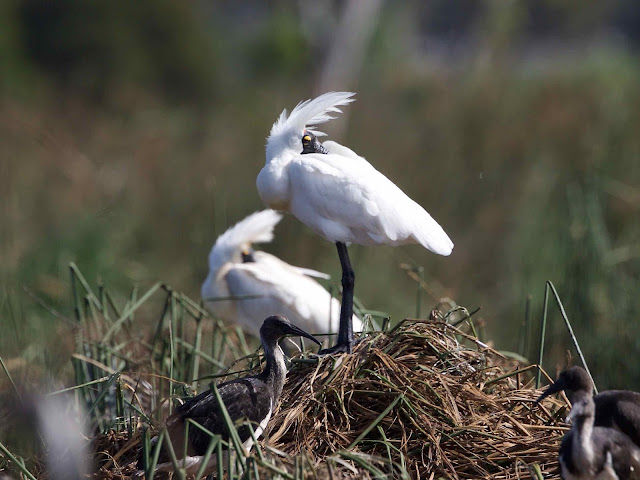The Royal Spoonbill (Platalea
regia) to my mind, and as the species name suggests, is a regal bird with brilliant
white plumage and starkly contrasting black face, bill and legs. They are
especially elegant in breeding condition when their heads are adorned with white
nuptial plumes.
 |
| Portrait of a regal bird. |
The Royal Spoonbill is moderately common in coastal and near coastal
wetlands in Gippsland where birds may be found singly, in pairs, or in small parties
and less often in large flocks. From my experience in East Gippsland a large flock
would typically contain between 20 and 30 birds, larger flocks up to 50 or 60
birds are rare.
There are few breeding records for Royal Spoonbills in East Gippsland,
for example “The Atlas of Australian Birds” and the “New Atlas” show no
breeding records in East Gippsland for this species or for Yellow Spoonbills.
For a number of years now I have been observing Royal Spoonbills in
small numbers roosting on the edge of the very large Ibis rookery in Macleod
Morass near Bairnsdale and speculating that the Spoonbills may be breeding.
This season there have been a larger than usual number of Royals on the edge of
the rookery for an extended time so I decided to take a closer look and see if
I could confirm breeding.
 |
| Part of the Ibis rookery in Macleod Morass. |
The Ibis build colonial nest sites by breaking down Giant Rush (Juncus ingens) reed stems to form
platforms. The rookery is moved each year to a new location. The Ibis do not
nest in Common Reed (Phragmites australis)
and Cumbungi (Typha orientalis), the
other two dominant aquatic plant stands found in Macleod Morass.
 |
| Royal Spoonbills on the far side of the Ibis rookery. |
The Ibis rookery contains mostly Straw-necked Ibis (Threskiornis spinicollis) and a smaller number of White (aka Sacred)
Ibis (Threskiornis molucca). The Straw-necked outnumber the White by about 4 to
1.
 |
| A typical - though a more isolated - example of an ibis breeding
platform on Giant Rush. |
As I walked by a row of large Red Gums a short distance from the rookery
at least 20 Whistling Kites and a pair of Swamp Harriers flew out. These and
other raptors such as White-bellied Sea-Eagles, have been feeding on Ibis
chicks and no doubt earlier on eggs, for the duration of the Ibis breeding
event. The chick and egg carnage is quite high, however as there are thousands
of Ibis, a majority of young birds successfully reach adulthood.
 |
| Close up of a vacated nest platform showing the remains of a number
of Ibis chicks - in the wild survival of the fittest rules. |
The Ibis young are now well advanced and have retreated from the more
isolated margins of the rookery to form crèches. Adult Ibis continually come
and go from the rookery on food gathering forays to the surrounding farm land. Excellent
fliers, they are capable of travelling long distances to gather food for their
young.
A dozen Straw-necked Ibis have been visiting our paddocks daily for over
a month now making a return trip of 28 kilometres from the rookery many times
each day.
 |
| Young Straw-necked Ibis gathered into a crèche. |
In all, I counted 50 Royal Spoonbills at the rookery and I estimate
there may have been up to another 10 birds out of sight giving a possible total
of 60 birds and more may have been away feeding. As mentioned above, 50 or 60
Royal Spoonbills in a loose flock is from my experience a large gathering of
this species in our area. All the spoonbills have nuptial plumes. Seven birds
looked to be sitting on nests with two birds out on their own and the others located
within the main flock of Royals on the edge of a large section of the Ibis
rookery.
Approaching the rookery, I was mindful of not disturbing the Ibis and Spoonbills
so I waded very slowly in stages in order to get close enough to the Royals for
observation and some photos.
The Royals appeared to prefer to construct nests in Giant Rush that is
not been packed down into a low platform as the Ibis do.
 |
| One of two Spoonbills on a suspected nest isolated from the main flock.
|
As I photographed a bird on one of the two isolated nests the bird
departed giving me a brief chance to check the nest to see if there were eggs
or chicks and thereby confirm for sure that the Royals are breeding. Royals typically
lay 2 or 3 eggs.
 |
| Adult Royal Spoonbill with nuptial plumes at nest. The male and female look the same and both share in incubation and raising the young. |
|
|
|
 |
| Royal Spoonbill nest with three eggs – note the leg of a young Ibis
on the upper edge of the nest. |
The bird soon returned to the nest and resumed incubation.
 |
| Two spoonbills at nests on the Ibis rookery with one bird settled on
the nest, presumably incubating eggs at this stage. | | | | | |
 |
| Another bird incubating and
sleeping at the same time. |
The Spoonbills must share the nesting site with the Ibis.
The Spoonbills have started their breeding late in the Ibis breeding
cycle, with eggs still being incubated at a time when the Ibis young are well
advanced. It is likely that the spoonbill young will hatch out and grow when
the Ibis have left the rookery.
Without the protection of a bigger group, the young Spoonbills will be
very vulnerable to the raptor predators now gathered in large numbers for the Ibis
breeding event. I will watch the Spoonbills with interest and concern and hope
they can successfully raise a new generation of Royal Spoonbills this breeding season.





















